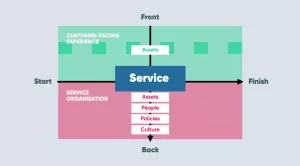- Viewpoint
There are all these flavours of design practice: service design, customer experience design, user experience design, content design, product design. They probably have more commonalities than differences and the fact that we need to explain them to each other is worrying!
And this list grows and morphs year after year. In the last few years, we’ve seen the advent of the product designer within digital teams. More recently I’ve seen a growth designer pop up. That’s surely not the last new discipline beating its drum. The ultimate goal of each of these disciplines is the same — to satisfy a user's need or goal and to drive the organisation forward. The difference is often around focus and remit.
In the digital space, we talk a lot about products rather than services. Many organisations have product teams with product owners supported by product designers working on fulfilling their product strategy by progressing through their product backlog. This, in my opinion, might limit our remit and do us an injustice. It’s something I’ve written about previously where I highlight that products are often vehicles for service provision.
Whether you are designing a ‘product’ or a ‘service’ it’s vital that everyone comes together to ensure that it works across both of its service dimensions.

Service dimensions
There are two critical dimensions to a service; end to end and front to back.
From end to end - All services comprise multiple moments that enable a user or customer to achieve their goals. The key to creating a compelling user experience is understanding the relationships between these moments digital and non-digital and designing across and between these moments.
From front to back - The concept of the front-stage and back-stage experience is well defined within the service design world. You can’t create exceptional service experience without looking at the process that delivers it.
In today’s world, the only logical approach is to start with the customer-facing service and its experience and then work inwards, engineering the optimal organisation to support the service. The role of the service organisation in the backstage is to support the service effectively, with its shape and structure built and adapted to suit. All too often the back-stage processes are overlooked, with new services built on top of dysfunctional organisations. But when back-stage organisational problems exist, they have front-stage consequences: poor service, customer frustration, and inconsistent channels. Streamlining back-stage processes is critical.

Pushing the service dimensions
As a designer, regardless of your remit you are in a unique position to push against these dimensions, to not only ensure that all touchpoints are well connected but also to shape the service organisation that supports them.
When designing a specific moment, it’s absolutely critical not to lose sight of where this moment sits within the broader service:
- What is its role?
- What is its relationship with other touchpoints?
- How might your design decisions influence other moments?
- Where does the content come from and what are the workflows that create it?
We did just that at Clearleft on a recent project with Brighton and Hove City Council. We were helping a department called Cityclean who are responsible for rubbish, recycling and street cleaning in the city.
Initially, we were asked to look at the form that citizens use to report issues such as graffiti, fly-tipping and broken glass. There was a feeling in the council that the form was difficult to use and that it was putting people off. They weren’t wrong. But by asking the right probing questions, we began to identify a much bigger service opportunity that we really enjoyed tackling:
- Who will use this information?
- What decisions or action will be taken based on the information collected?
- How will issues be tracked and monitored?
So when you are designing anything, no matter how small or how broad, consider all dimensions. Even if you don’t initially have the remit, push to the outer edges by asking probing questions around context. Then quickly build momentum by visualising the opportunity and making it real.
Good luck everyone in pushing those dimensions.
Related thinking
- Viewpoint
Supporting your customer support staff with internal service design
- Viewpoint

